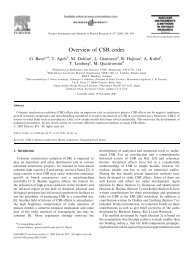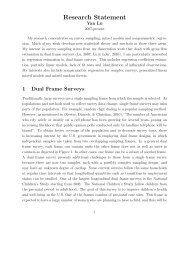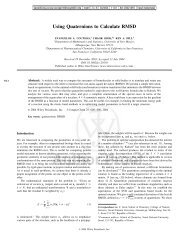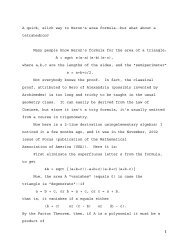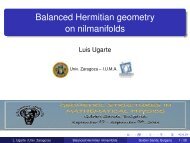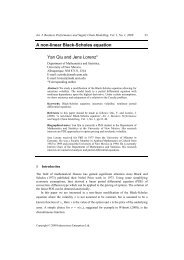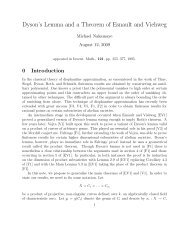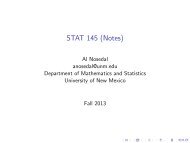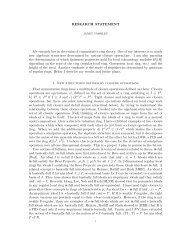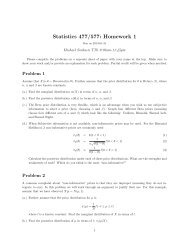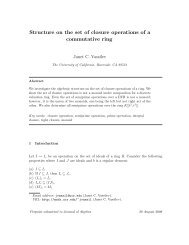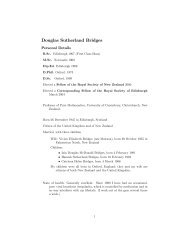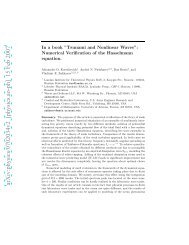OEO Office of Equal Opportunity - Department of Mathematics and ...
OEO Office of Equal Opportunity - Department of Mathematics and ...
OEO Office of Equal Opportunity - Department of Mathematics and ...
Create successful ePaper yourself
Turn your PDF publications into a flip-book with our unique Google optimized e-Paper software.
JAPANESE 205<br />
101. Beginning Greek I. [Elementary Greek.] (3)<br />
Introduction to Classical Greek. {Fall}<br />
102. Beginning Greek II. [Elementary Greek.] (3)<br />
Readings from simple prose.<br />
104. New Testament Greek. (1-6 to a maximum <strong>of</strong> 6) ∆<br />
(Also <strong>of</strong>fered as RELG 104.) Introduction to New Testament<br />
Greek. Six hours is the equivalent <strong>of</strong> one year <strong>of</strong> Greek.<br />
107. Greek Mythology. (3)<br />
(Also <strong>of</strong>fered as CLST, ENGL 107.) Introduction to mythology;<br />
primary readings in stories about the gods <strong>and</strong> heroes, usually<br />
including Homer, Hesiod, Homeric Hymns <strong>and</strong> Tragedies.<br />
All texts will be in English.<br />
*475. Dante in Translation. (3)<br />
(Also <strong>of</strong>fered as RELG 475.) Principally the Vita Nuova <strong>and</strong><br />
the Divine Comedy.<br />
497. Undergraduate Problems. (1-6 to a maximum <strong>of</strong> 6)<br />
Restriction: permission <strong>of</strong> instructor.<br />
498. Reading <strong>and</strong> Research for Honors. (6)<br />
Open for Juniors <strong>and</strong> Seniors approved by Honors<br />
Committee.<br />
Restriction: permission <strong>of</strong> instructor.<br />
499. Honors Essay. (3)<br />
Open to Seniors enrolled for departmental honors.<br />
Restriction: permission <strong>of</strong> supervising instructor.<br />
201. Intermediate Greek I. [Intermediate Greek.] (3, 3)<br />
Systematic review <strong>of</strong> Greek grammar <strong>and</strong> syntax; reading <strong>of</strong><br />
authors such as Plato <strong>and</strong> Herodotus.<br />
202. Intermediate Greek II. [Intermediate Greek.] (3, 3)<br />
Systematic review <strong>of</strong> Greek grammar <strong>and</strong> syntax; reading <strong>of</strong><br />
authors such as Plato <strong>and</strong> Herodotus.<br />
*301. Advanced Greek I. [Classical Greek.] (3, 3, no<br />
limit) ††<br />
Readings in Homer, Sophocles, Euripides, Plato <strong>and</strong> the<br />
New Testament, depending on the level <strong>and</strong> interests <strong>of</strong><br />
the class.<br />
*302. Advanced Greek II. [Classical Greek.] (3, 3, no<br />
limit) ††<br />
Readings in Homer, Sophocles, Euripides, Plato <strong>and</strong> the<br />
New Testament, depending on the level <strong>and</strong> interests <strong>of</strong><br />
the class.<br />
497. Undergraduate Problems. (1-6 to a maximum <strong>of</strong><br />
6) ∆<br />
551. Graduate Problems. (1-9 to a maximum <strong>of</strong> 9) ∆<br />
Italian (ITAL)<br />
Rachele Duke, Advisor, Ortega Hall 327C, 277-7371<br />
rduke@unm.edu<br />
Minor Study Requirements<br />
Twenty-four hours <strong>of</strong> course work distributed as follows: 6<br />
hours above the 275–276 Italian language level; no fewer<br />
than 9 hours in the following History courses: 302, 303, 304,<br />
305, (readings courses or seminars subject to approval); no<br />
fewer than 9 hours in the following Art History courses: 261,<br />
262, 331, 332, 340, 429 or Media Arts courses: 330, 428<br />
(readings courses or seminars subject to approval); certain<br />
courses in Latin may also apply <strong>and</strong> are subject to approval.<br />
275–276. Accelerated Elementary Italian–Accelerated<br />
Intermediate Italian. [Beginning Italian (Accelerated).] (6,<br />
6)<br />
Intensive course for serious beginning students. 275 equivalent<br />
to 101–102. 276 equivalent to 201–202. {Fall, Spring}<br />
*307. Survey <strong>of</strong> Italian Literature I. (3)<br />
A survey <strong>of</strong> Italian culture as reflected in literary texts from the<br />
Middle Ages to the Renaissance.<br />
*308. Survey <strong>of</strong> Italian Literature II. (3)<br />
A survey <strong>of</strong> Italian culture as reflected in literary texts from the<br />
Renaissance to the present.<br />
337. Topics in Italian Literature <strong>and</strong> Culture in<br />
Translation. [Italian Literature <strong>and</strong> Culture in Translation.]<br />
(3 to a maximum <strong>of</strong> 6) ∆<br />
(Also <strong>of</strong>fered as ENGL, COMP 337.) Study <strong>of</strong> individual<br />
authors, genres, <strong>and</strong>/or periods <strong>of</strong> Italian literature <strong>and</strong> culture<br />
in translation.<br />
551. Honors Essay. (3)<br />
Open only to Seniors enrolled for departmental honors.<br />
Restriction: permission <strong>of</strong> supervising instructor.<br />
Japanese (JAPN)<br />
Lorna Brau, Advisor, Ortega Hall 353C, 277-3683<br />
lbrau@unm.edu<br />
Minor Study Requirements<br />
Eighteen hours in courses numbered above 200. Of these,<br />
six hours are selected from Japanese language courses<br />
at the 201 level or above, with the remaining 12 hours <strong>of</strong><br />
courses selected from 301, 302, 320, 339, 411 <strong>and</strong> HIST 384.<br />
In addition, the 18 hours may include 3 hours <strong>of</strong> independent<br />
study with Japanese studies faculty on a Japan-related topic<br />
under JAPN 497.<br />
First-Year Program<br />
All beginning students should enroll in Basic Japanese (101<br />
followed by 102), which provides a foundation in language<br />
skills for all subsequent courses.<br />
Second-Year Program<br />
All second-year Japanese students should enroll in Intermediate<br />
Japanese (201 followed by 202), which continues the development<br />
<strong>of</strong> all language skills. Students intending to go beyond the<br />
second year should sign up for 301/302. Transfer students <strong>and</strong><br />
those who have studied Japanese in high school should seek<br />
advice from a member <strong>of</strong> the Japanese faculty.<br />
101. Elementary Japanese I. [Basic Japanese.] (3)<br />
Foundation course for all beginning students, with instruction<br />
in speaking, listening, reading <strong>and</strong> writing. {Fall}<br />
102. Elementary Japanese II. [Basic Japanese.] (3)<br />
Second half <strong>of</strong> foundation course 101. {Spring}<br />
201. Intermediate Japanese I. [Intermediate Japanese.]<br />
(3)<br />
Continues development <strong>of</strong> four language skills (speaking, listening,<br />
reading <strong>and</strong> writing) at the third semester level. {Fall}<br />
202. Intermediate Japanese II. [Intermediate Japanese.]<br />
(3)<br />
Continuation <strong>of</strong> 201. {Spring}<br />
297. Language & Culture. (3) ∆<br />
This course introduces numerous aspects <strong>of</strong> business life <strong>and</strong><br />
etiquette, <strong>and</strong> language necessary for a variety <strong>of</strong> business<br />
transactions. Realistic dialogue <strong>and</strong> useful practice exercises,<br />
such as initial meetings, telephone conversations, company<br />
tours, business conversations <strong>and</strong> the like appear throughout<br />
the course. May be repeated up to 6 credit hours.<br />
ARTS AND<br />
SCIENCES<br />
UNM CATALOG 2006–2007 Symbols, page 611.



